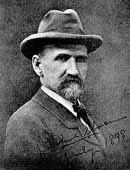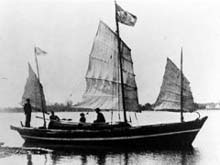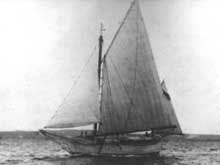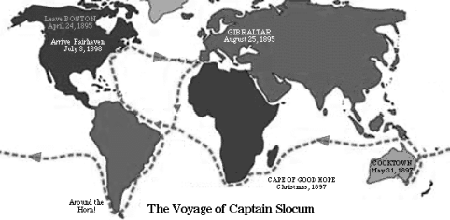Captain Joshua Slocum
First man to single-handedly sail around the world
Every now and then you read about someone whose life is an adventure better than any novel.
Captain Joshua Slocum was born on 20 February 1844 in Nova Scotia. He was the fifth of eleven children. His father was a hard disciplinarian and from his early teens, he made several attempts to run away to the sea. At the age of fourteen he became cook on a local fishing schooner and soon afterwards he and a friend shipped out on a droger bound for Dublin. From Dublin, he went to Liverpool becoming an ordinary seaman on the British merchant ship Tangier which was bound for China. As a seaman, he rounded Cape Horn twice, touched at Batavia (now Jakarta), the Moluccas, Manila, Hong Kong, Saigon, Singapore, and San Francisco. While at sea he studied for the Board of Trade Examination and at the age of 18 received his certificate as Second Mate. In San Francisco, he became an American Citizen and after a stint at salmon fishing and fur hunting, he returned to the sea piloting a coastal schooner. His first command in 1869 was the barque Washington which he took across the Pacific from San Francisco to Australia and then onwards to Alaska. In 1871, while in Sidney, he married his first wife, an American named Virginia Walker. They went on to have four children, all born in different countries.
In remote Alaska, the Washington ended up dragging her anchor during a gale, ran ashore and was a total loss. However, Slocum managed to save the cargo and crew, bringing them back safely in the ship's open boats. The shipping company was impressed by this feat of leadership and seamanship and gave him command of the Constitution which he sailed to Honolulu and later Mexico. After the Constitution He commanded the Benjamin Aymar in the South Seas. However, when the owner sold the vessel, he became stranded in the Philippines. There he organized native workers to build a 150 ton steamship and in partial payment for the work was given the 90 ton schooner, Pato. Reviving his fortunes, he crossed the North Pacific to British Columbia. During this period, Slocum fulfilled his wish to become a writer by becoming a temporary correspondent for the San Francisco Bee. Crossing to Hawaii, he sold the Pato and bought the Amethyst which he sold in Hong Kong for an interest in the full-rigged ship Northern Light. This was his "best command" and was considered the "finest American sailing vessel afloat" at the time. However after two years he sold his interest and bought the barque Aquidneck in which he sailed to Buenos Aires. While there his wife, Virginia, died at the age of 35. They were quite close and he took the loss hard. The following year, 1886, he married his cousin Henrietta Elliott and the Aquidneck ran between Baltimore and South America. During this time he lived through a cholera epidemic, an outbreak of smallpox (which killed several of his crew), and later a mutiny in which he was forced to shoot two men. A few months later, in 1887, his ship ran aground and broke up in Brazil, marooning him and his family and ruining his fortunes. Unwilling to return to the United States as a castaway and a pauper, he used native help and the wreckage of his ship to build a 35 foot, junk rigged, dory which he named "Liberdade". The next year he, his wife, and children sailed this small, homemade craft across 5,500 miles of open ocean to South Carolina. Slocum wrote his first book "Voyage of the Liberdade" about the trip. In recognition for this feat the Liberdade was placed on view at the Smithsonian Institution.

After their return from Brazil, Slocum's wife refused to go to sea again. Slocum next took the job of delivering the steam powered, ironclad, torpedo boat "Destroyer" from New York to Brazil to aid in putting down a revolution. The ship did not prove particularly sea worthy and the trip became an ongoing battle to keep her from foundering in the rough seas encountered. Adding insult, the Brazilian government took delivery of the boat and never paid him for his services. Upon returning, he recounted this new adventure in a second book.
By this time, the age of sail was being replaced by the age of steam and like many older captains, Slocum fell on hard times. His books were not particularly successful and he worked as a shipwright until 1892. At this time a friend gave him the hull of an old Chesapeake Bay oyster sloop named Spray which was rotting in a field by Fairhaven, Massachusetts. Many believe the gift was a joke. However, Slocum salvaged parts of the old hull to build a new and slightly larger boat, drawing his considerable experience into her design. Although he always referred to the new cutter rigged 37 foot Spray as a sloop, later an aft spar was added and she was turned into a yawl. The sawed off and boarded up bow of a cape dory skiff became his tender.
Slocum was determined to become the first man to single-handedly sail around the globe. On 24 April 1895 Captain Joshua Slocum and Spray of Boston slipped off on their journey. He was over 50 years old at the time, had no private funding, no modern navigational equipment, and his only chronometer was a damaged tin clock. Many said a solo circumnavigation was impossible. However, he was aided by the remarkably well balanced design of Spray which allowed her to remain true to course with the wheel lashed.



Slocum first crossed the Atlantic and had intended a route past Gibraltar, into the Mediterranean, and through the Suez Canal. However, after being chased by and very narrowly escaping capture by Moorish pirates, he turned around, and decided to re-cross the Atlantic, taking a safer westerly route. He headed down and around the coast of South America, through the Straight of Magellan. There he fought off many storms and on several occasions hostile aboriginals. He was forced to adopt such tricks as going down one hatch, changing clothes and emerging out the other to make it look like several people were on board. His precaution of covering the deck with carpet tacks at night saved him once when natives stealthily slipped aboard while he was asleep. From the Straight he crossed to Australia and Tasmania, then around Africa and the Cape of Good Hope. From there he crossed the Atlantic a third time, returning up the coast of South America, through the Caribbean (without charts), and back to Fairhaven, Massachusetts. On 03 July 1898 he tied Spray up to the same mooring post he had left from 3 years and two months before.

Slocum rapidly became a celebrity as news of each leg was broadcast throughout the western world. However, his feat was somewhat overshadowed by the Spanish American War. Upon returning he wrote a book about his experiences titled: Sailing Alone Around The World. This adventure became a best seller and has been on the reading lists of many schools throughout the century. (It is still in print and is a wonderful and quick read.)

Proceeds from the book and lectures allowed him to buy a house in Martha's Vineyard. However, he continued to be called by the sea. On 14 November 1909 at age 65, Captain Slocum set sail on his fourth annual trip in Spray to the West Indies. He was sited that day by a Schooner that warned him of an approaching gale. He was never seen or heard from again. It is hypothesized that he may have collided with a large steamer at night in the shipping lanes.